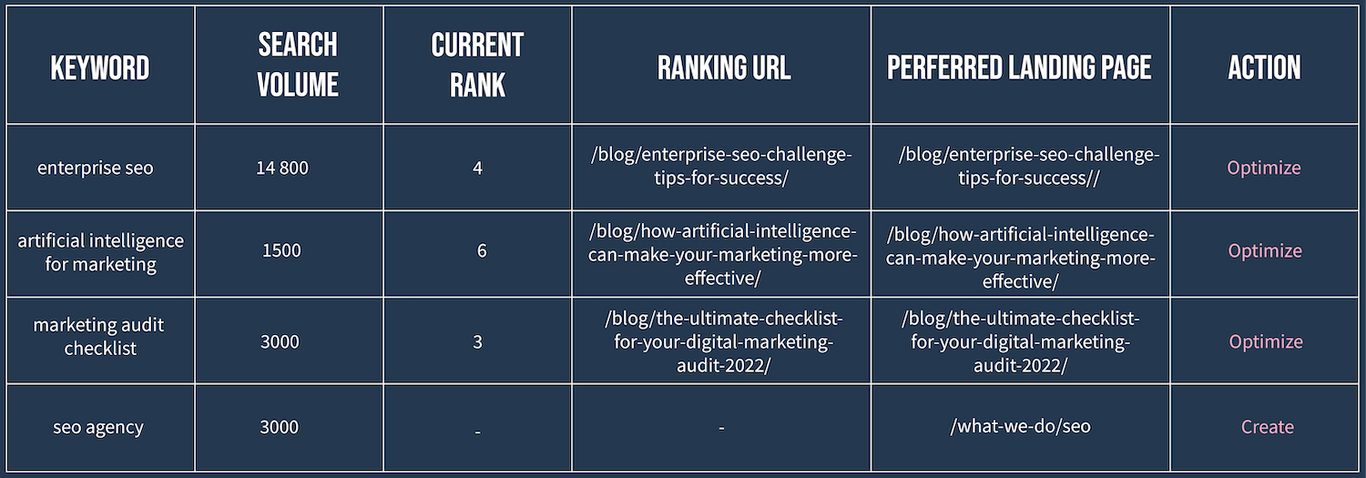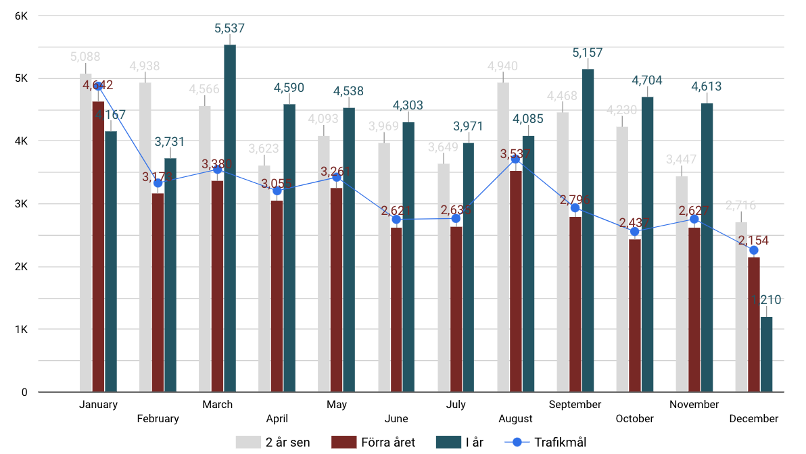SEO and Paid Media
SEO content optimization in 5 steps
12/15/22
Are you planning a new website, or wondering how to rank better in Google and drive more organic traffic to your existing site? Step inside the world of search engine optimization (SEO) and content creation with our five-step guide to creating SEO-optimized content like a pro. Get started today!
For most of us, the search engine giant Google has become an inescapable part of our lives. Even before its official inclusion in the dictionary as a verb back in 2006, googling has been our daily go-to action whenever we want to find something. Whether you’re looking up those noise-canceling headphones you’ve been thinking about buying, job vacancies you might be interested in, or what restaurant nearby has the best reviews, as the world’s largest search engine (by far), we rely on it for many of our purchasing and even life decisions.
What is the benefit of SEO optimization?
As we mentioned in our earlier blog post about overcoming the challenges of enterprise SEO, around one-third of clicks in Google search results go to the top-ranking result – and almost 90% go to the first page. So, from a business or brand perspective, if you want that traffic heading to your website rather than your competitors, it pays to rank well for the search terms that are relevant to what you’re offering.
What factors impact search engine visibility?
Several different factors contribute to your page ranking in Google, which means there are different areas you could focus on in an SEO project. The three main pillars to successful SEO are content, technical elements and linking. If you know your site is particularly weak in one of these areas, you might already know what type of project or campaign is right for you.
For those who are creating a new site, or who have a site but haven’t set out on their SEO journey yet, content optimization is often the best place to start. This is why, in this post, we’re going to focus on SEO content campaigns, running you through the five key steps to successfully set up and activate a content optimization campaign to improve your rankings – and visibility.
Step 1: Assess your situation – start with what you have
This first research step is all about working out where you are now. Start with an audit of your existing content (if you have any). Make an inventory of all your pages. Which ones are currently getting the most organic traffic and conversions? Which keywords is your site already ranking for? Use tools like Google Search Console, Ahrefs, and Accuranker to check your rankings.
By the time you’ve finished this, you should have a good overview of your content, what’s performing well and where there’s room for improvement. If your content is performing well, where are the gaps – what opportunities are there to market your brand or product through the creation of new content?
This is also a great time to put together an initial set of data for benchmarking – a snapshot of where things are now with all your pages before you start your campaign. This will enable you to analyze and compare your results from before and after the campaign implementation.
If you don’t have any content yet, start by looking at the market landscape. Research what your competitors are ranking for. Once you’ve read through the rest of these steps, you can even look at the competitors who are getting top rankings, and try to work out what they’re doing right on their pages. Are there things you could do even better?
Step 2: Set your expectations and goals
Now you’ve got a clear overview, it’s time to sit down and get realistic. At this stage, it’s good to do a bit of expectation-setting.
Think about what it is you’re trying to market. Is it a product or service, or positioning a brand? What is it you want to achieve – greater awareness, information, leads or sales? Based on this, what sort of traffic (audiences) are you trying to attract? What actions are you trying to get people to take? Given these answers, what do we need to measure to determine success?
The key performance indicators (KPIs) you choose to measure the success of your campaign should be chosen depending on what you’re trying to achieve. These might include:
- Number of sessions for the website in total
- Number of sessions to particular pages
- Customer Lifetime Value (CLV)
- Average Engagement Time
- Conversions (signups, contacts, purchases etc.)
- Types of visibility in SERP
It can be easy to feel overwhelmed, or try to achieve everything at once, but remember your SEO project should only be as large and complex as is manageable. Successful SEO isn’t a one-and-done project – it’s a marathon, not a sprint. Of course, having your whole website fully optimized and ranking well across the board is the dream goal, but it’s much better to start with a selection of pages and get started now, than put it off for a year to do the whole lot at once. If you have limited resources, start off with just the pages for a priority business area and go from there.
Step 3: Identify opportunities with keyword research
Once you’ve established the goals you’re trying to achieve and what areas you’re going to start focusing on, you can get started on some concrete keyword research. From step one, you might already have a list of key search terms or phrases your customers are looking for – try to expand on that as much as possible based on your market and customer knowledge. Now let’s look at these keywords a bit more closely, with a real data-driven, evidence-based approach to identify what is worth optimizing for.
The most important thing to keep in mind when choosing keywords is the search intent behind them. You need to try and understand what people are expecting to find when searching for a particular term. Think about what they are trying to achieve. Are they looking to buy something, compare something, or be informed? Is there anything else this term might mean? Make sure the terms are relevant for your particular page or site.
The pandemic brought us a great example of a shift in search intent for a keyword. In 2019, a Google search for ‘face masks’ would likely have shown either costume stores or skincare supplies. Fast forward a year or so, and it was bulk packs of medical masks for day-to-day usage. So keywords can not only have multiple (conflicting) audiences, but the dominant search intent can also change over time!
How do I know if a keyword is relevant?
If you’re ever unsure if a keyword is a good fit, the best way to gain an understanding of the search intent behind it is to simply google the keyword yourself. If the top results seem relevant, it’s likely a good match. If the top-ranking pages are about a different topic entirely, this might not be a good choice. It’s also good to consider if your keywords suit your target audience within that topic – for example, the keyword “buy remote control car” might be great for a B2C toy store, but not so useful for a B2B toy wholesaler.
Research the monthly search volume
Now is the time to look into the true SEO potential of those terms, by finding out their search volumes. There are several tools available when it comes to keyword research – two that we like to use are Ahrefs and Google Keyword Planner. Find out which of the keywords have a high monthly search volume, and which have low search volumes.
I like to work with a keyword map. It’s a planning tool where you can have a structured overview of your site and your target keywords with actions. You don’t need any fancy tools to build this either, you can just structure something simple like the below example in Excel.

We recommend identifying both primary and secondary keywords to be optimized for, where possible. The primary keyword will represent the main overarching topic, while the secondary keyword should still be related to the main topic but is either more specific and detailed or gives some additional information about the content that will be covered on the page.
What if there is no search volume for a keyword we want to use?
You can still create content around a topic, even if there is no search volume. We call this ‘push’ content – content that you need to push traffic to, rather than ‘pull’ content, that pulls traffic from its organic search results thanks to keyword optimization! Just keep in mind that push content won’t be gaining any boosts in organic traffic from search.
If you need to drive more traffic to these pages, ensure this is being done in other ways, such as linking from other pages, investing in paid search advertising, or pushing the content through social media channels.
Step 4: Optimize and create data-driven content!
To optimize your page, you’ll want to incorporate your primary and secondary keywords in the text. If you’re not writing the content yourself, this step requires strong collaboration with your copywriters. Where possible, (without turning your page into a repetitive keyword salad), the keywords should be worked into the:
- Page headline
- Introductory / lead paragraph at the top of the page
- Subheadings
- Meta title
- Meta description
Hot tip: Don’t forget to ensure meta titles and descriptions are within the recommended character limits – up to 60 characters for the title and 150-160 for the description!
Whether you’re creating new pages or optimizing existing content, make sure your content is of good quality and easy to read and understand. There’s no point driving traffic to a page that is confusing, irrelevant, or not interesting to the user – they will just bounce (leave the page) straight away! Be engaging and concise. Cover what you know the visitor will be interested in or looking for when visiting the page. Break down your content into sections with clear subheadings for easy skim-reading.
Remember to also keep the focus on what behavior or action you want the user to take – do you have a clear call-to-action (CTA) near the top of the page? Other ways for the user to stay engaged within your website environment if they reach the bottom of the page, such as suggestions for related content?
Don’t forget to add links!
When the content is written, always review it to ensure it follows your recommendations for optimization. Be sure to add any relevant internal links to other pages where relevant (being sure to incorporate the keywords for that page in the link for pages that have been optimized) as well as external links to any other reputable sources mentioned in the text. If you’re creating a new page, remember to think about what other pages you can cross-link your new page from as well. Do you already refer to this topic or related topics somewhere else on the site? Add a link!
If the content campaign is relatively big, it's worth investing in a full linking audit to identify internal unlinked mentions on the site and make sure you’re covering all relevant internal links.
Once the page content is optimized and all links added, you’re ready – click publish and let’s go live!
Step 5: Review performance and plan ongoing optimization
Congratulations! You’ve activated your SEO content campaign and published your optimized pages. Yay! But what now?
As we established in the second step, SEO is an ongoing process, not a one-off effort. Your rankings and performance should also be monitored over time – not only can the search intent behind keyword searches change, as we saw earlier with the face masks, but Google’s algorithms are also constantly being updated. What worked last year might not be quite so effective now, and before you know it your high-ranking page is down to page two of the SERP!
Get the right SEO tools to monitor your performance
Use an SEO ranking tool (like we mentioned in step one) for monitoring how your new or updated pages are performing with SERP rankings. These allow you to follow your rankings and check them as often as you need. You’ll also need a web analytics tool to follow organic traffic and any web-based KPIs or goals such as on-page conversions, such as Google Analytics.
How often should I review my content’s performance?
SEO results don’t happen overnight! It can take some time before Google indexes your new or updated pages and you start to see the results of your work. I suggest checking in Google Search Console 2-3 days after publishing to make sure Google has indexed the new content. After that, check in regularly – once a month is a good frequency if you have time. Look at metrics such as ranking position of your pages to analyze your performance and work out where further optimization is needed. Keep in mind that some content might have more demand in certain seasons and may therefore have “bad” and “good” months when it comes to the search volume. Here are some key questions you might want to look out for:
- Pages that are performing really well (Celebrate!)
- Where content can be improved for better rankings (Optimize!)
- A single page covering content about multiple potential primary keywords (Split the content onto separate optimized pages!)
- Old or duplicate content inhibiting your rankings (Retire or revamp it!)
- Opportunities around a hot or not fully utilized keyword (Create new content!)
Your follow-up and ongoing review process of your implemented SEO content campaign can be as simple or as complex as you want to make it. If you’re going for a light approach, you can simply follow the performance of pages you’re interested in when you want using Google Search Console and check the status of your rankings once in a while – maybe even just once or twice a year. The important thing is to review your keywords and KPIs in a reliable and consistent way.
In more complex campaigns, I like to use a custom dashboard to follow ranking performance and understand what keywords are driving traffic, and where the traffic lands. This means all the data can be brought together and displayed in one place – your keyword map, rankings from your ranking tool, sessions, and conversions from your analytics tool – then compared month over month. You can also look at the results in chart formats or map select pages in relevant groupings – it’s a really nice way of showing the performance visually in an easy-to-understand format.

An example of a column chart in a dashboard following monthly website sessions over three years.
Remember that how people are searching is changing over time – and so must your optimization. If you’ve created evergreen content, it may need to be updated to re-optimize and keep it ranking high for the topic in question. Meanwhile, you might be retiring old, formerly ‘hot’ topic pages that are no longer ranking and writing new optimized content in line with the latest trends.
Whatever scale of SEO content campaign you’re thinking about, these five steps – even in a simplified format – are the secret to success. Get started today and soon you’ll see your content getting those prized top spots!
Prefer to leave your SEO optimization and content strategies to the professionals?
No problem – contact us and we’ll be happy to help!
By Fanny Pettersson SEO Consultant



